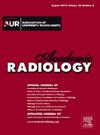Predicting the Prognosis of HIFU Ablation of Uterine Fibroids Using a Deep Learning-Based 3D Super-Resolution DWI Radiomics Model: A Multicenter Study
IF 3.8
2区 医学
Q1 RADIOLOGY, NUCLEAR MEDICINE & MEDICAL IMAGING
引用次数: 0
Abstract
Rationale and Objectives
To assess the feasibility and efficacy of a deep learning-based three-dimensional (3D) super-resolution diffusion-weighted imaging (DWI) radiomics model in predicting the prognosis of high-intensity focused ultrasound (HIFU) ablation of uterine fibroids.
Methods
This retrospective study included 360 patients with uterine fibroids who received HIFU treatment, including Center A (training set: N = 240; internal testing set: N = 60) and Center B (external testing set: N = 60) and were classified as having a favorable or unfavorable prognosis based on the postoperative non-perfusion volume ratio. A deep transfer learning approach was used to construct super-resolution DWI (SR-DWI) based on conventional high-resolution DWI (HR-DWI), and 1198 radiomics features were extracted from manually segmented regions of interest in both image types. Following data preprocessing and feature selection, radiomics models were constructed for HR-DWI and SR-DWI using Support Vector Machine (SVM), Random Forest (RF), and Light Gradient Boosting Machine (LightGBM) algorithms, with performance evaluated using area under the curve (AUC) and decision curves.
Result
All DWI radiomics models demonstrated superior AUC in predicting HIFU ablated uterine fibroids prognosis compared to expert radiologists (AUC: 0.706, 95% CI: 0.647–0.748). When utilizing different machine learning algorithms, the HR-DWI model achieved AUC values of 0.805 (95% CI: 0.679–0.931) with SVM, 0.797 (95% CI: 0.672–0.921) with RF, and 0.770 (95% CI: 0.631–0.908) with LightGBM. Meanwhile, the SR-DWI model outperformed the HR-DWI model (P < 0.05) across all algorithms, with AUC values of 0.868 (95% CI: 0.775–0.960) with SVM, 0.824 (95% CI: 0.715–0.934) with RF, and 0.821 (95% CI: 0.709–0.933) with LightGBM. And decision curve analysis further confirmed the good clinical value of the models.
Conclusion
Deep learning-based 3D SR-DWI radiomics model demonstrated favorable feasibility and effectiveness in predicting the prognosis of HIFU ablated uterine fibroids, which was superior to HR-DWI model and assessment by expert radiologists.
使用基于深度学习的三维超分辨率 DWI 放射线组学模型预测子宫肌瘤 HIFU 消融术的预后:一项多中心研究。
原理与目标评估基于深度学习的三维(3D)超分辨率弥散加权成像(DWI)放射组学模型预测子宫肌瘤高强度聚焦超声(HIFU)消融术预后的可行性和有效性:这项回顾性研究纳入了360名接受HIFU治疗的子宫肌瘤患者,包括A中心(训练集:N = 240;内部测试集:N = 60)和B中心(外部测试集:N = 60),并根据术后非灌注容积比分为预后良好和预后不良。在传统高分辨率 DWI(HR-DWI)的基础上,采用深度迁移学习方法构建了超分辨率 DWI(SR-DWI),并从两种图像类型中人工分割的感兴趣区提取了 1198 个放射组学特征。在数据预处理和特征选择之后,使用支持向量机(SVM)、随机森林(RF)和光梯度提升机(LightGBM)算法为 HR-DWI 和 SR-DWI 构建了放射组学模型,并使用曲线下面积(AUC)和决策曲线对性能进行了评估:结果:与放射科专家相比,所有DWI放射组学模型在预测HIFU消融子宫肌瘤预后方面的AUC均优于专家(AUC:0.706,95% CI:0.647-0.748)。在使用不同的机器学习算法时,HR-DWI 模型的 AUC 值分别为:SVM:0.805(95% CI:0.679-0.931);RF:0.797(95% CI:0.672-0.921);LightGBM:0.770(95% CI:0.631-0.908)。同时,SR-DWI 模型优于 HR-DWI 模型(P 结论:SR-DWI 模型优于 HR-DWI 模型:基于深度学习的三维SR-DWI放射组学模型在预测HIFU消融子宫肌瘤的预后方面表现出了良好的可行性和有效性,优于HR-DWI模型和放射科专家的评估。
本文章由计算机程序翻译,如有差异,请以英文原文为准。
求助全文
约1分钟内获得全文
求助全文
来源期刊

Academic Radiology
医学-核医学
CiteScore
7.60
自引率
10.40%
发文量
432
审稿时长
18 days
期刊介绍:
Academic Radiology publishes original reports of clinical and laboratory investigations in diagnostic imaging, the diagnostic use of radioactive isotopes, computed tomography, positron emission tomography, magnetic resonance imaging, ultrasound, digital subtraction angiography, image-guided interventions and related techniques. It also includes brief technical reports describing original observations, techniques, and instrumental developments; state-of-the-art reports on clinical issues, new technology and other topics of current medical importance; meta-analyses; scientific studies and opinions on radiologic education; and letters to the Editor.
 求助内容:
求助内容: 应助结果提醒方式:
应助结果提醒方式:


